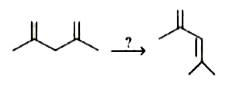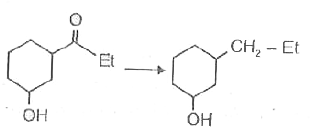Which of the following reagents would not be a good choice for reducing an aryl nitro compound to an amine?
H2(excess)/Pt
LiAlH4 in ether
Fe and HCl
Sn and HCl
To determine which reagent would not be a good choice for reducing an aryl nitro compound to an amine, we need to analyze the common reducing agents used in such reactions and identify the one that does not effectively perform this transformation.
1. Understanding the Reaction:
- Aryl nitro compounds (like nitrobenzene) can be reduced to aryl amines (like aniline) through various reducing agents.
2. Common Reducing Agents:
- Common reagents for this reduction include:
- Tin (Sn) with hydrochloric acid (HCl)
- Iron (Fe) with HCl
- Hydrogen gas (H2) with a catalyst (like palladium or platinum)
- Lithium aluminum hydride (LiAlH4)
3. Analyzing Lithium Aluminum Hydride (LiAlH4):
- While LiAlH4 is a strong reducing agent, it is known to reduce nitro compounds to azo compounds (C6H5N=N-C6H5) instead of amines. This means that it does not effectively convert aryl nitro compounds to aryl amines.
4. Conclusion:
- Based on the analysis, the reagent that would not be a good choice for reducing an aryl nitro compound to an amine is Lithium Aluminum Hydride (LiAlH4).
Final Answer:
- The reagent that would not be a good choice for reducing an aryl nitro compound to an amine is LiAlH4.
- Aryl nitro compounds (like nitrobenzene) can be reduced to aryl amines (like aniline) through various reducing agents.
- Common reagents for this reduction include:
- Tin (Sn) with hydrochloric acid (HCl)
- Iron (Fe) with HCl
- Hydrogen gas (H2) with a catalyst (like palladium or platinum)
- Lithium aluminum hydride (LiAlH4)
- While LiAlH4 is a strong reducing agent, it is known to reduce nitro compounds to azo compounds (C6H5N=N-C6H5) instead of amines. This means that it does not effectively convert aryl nitro compounds to aryl amines.
- Based on the analysis, the reagent that would not be a good choice for reducing an aryl nitro compound to an amine is Lithium Aluminum Hydride (LiAlH4).
- The reagent that would not be a good choice for reducing an aryl nitro compound to an amine is LiAlH4.
Topper's Solved these Questions
- AMINES BOOK - NCERT FINGERTPS ENGLISHCHAPTER - AMINES EXERCISE - NCERT EXEMPLER PROBLEMS
3 Videos
- AMINES BOOK - NCERT FINGERTPS ENGLISHCHAPTER - AMINES EXERCISE - ASSERTION & REASON CORNER
14 Videos
- AMINES BOOK - NCERT FINGERTPS ENGLISHCHAPTER - AMINES EXERCISE - HOTS
6 Videos
- ALDEHYDES, KETONES AND CARBOXYLIC ACIDSBOOK - NCERT FINGERTPS ENGLISHCHAPTER - ALDEHYDES, KETONES AND CARBOXYLIC ACIDSEXERCISE - Assertion And Reason
15 Videos
- BIOMOLECULESBOOK - NCERT FINGERTPS ENGLISHCHAPTER - BIOMOLECULESEXERCISE - Assertion And Reason
15 Videos
Similar Questions
Knowledge Check

Which of the following reagents will not react with above compound ?ANa metalBAgNO3+NH4OHCCu2Cl2+NH4OHDNaHCO3Which of the following reagents would convert an aldose into corresponding aldonic acid?
ATollen's reagentBFehling's solutionCBromine waterDRed P+HIWhich of the following reagents would best accomplish the following transformations?
 AExcess B2H6,NaOH/H2O2 followed by OsO4BExcess Hg(OAc)2/H2O,NaBH4ΘOH followed by H2SO4,ΔCO3,Zn/H2O followed by Hg(OAc)2/H2O,NaBH4,ΘOHDOsO4,NaHSO3 followed by NaOH
AExcess B2H6,NaOH/H2O2 followed by OsO4BExcess Hg(OAc)2/H2O,NaBH4ΘOH followed by H2SO4,ΔCO3,Zn/H2O followed by Hg(OAc)2/H2O,NaBH4,ΘOHDOsO4,NaHSO3 followed by NaOH

